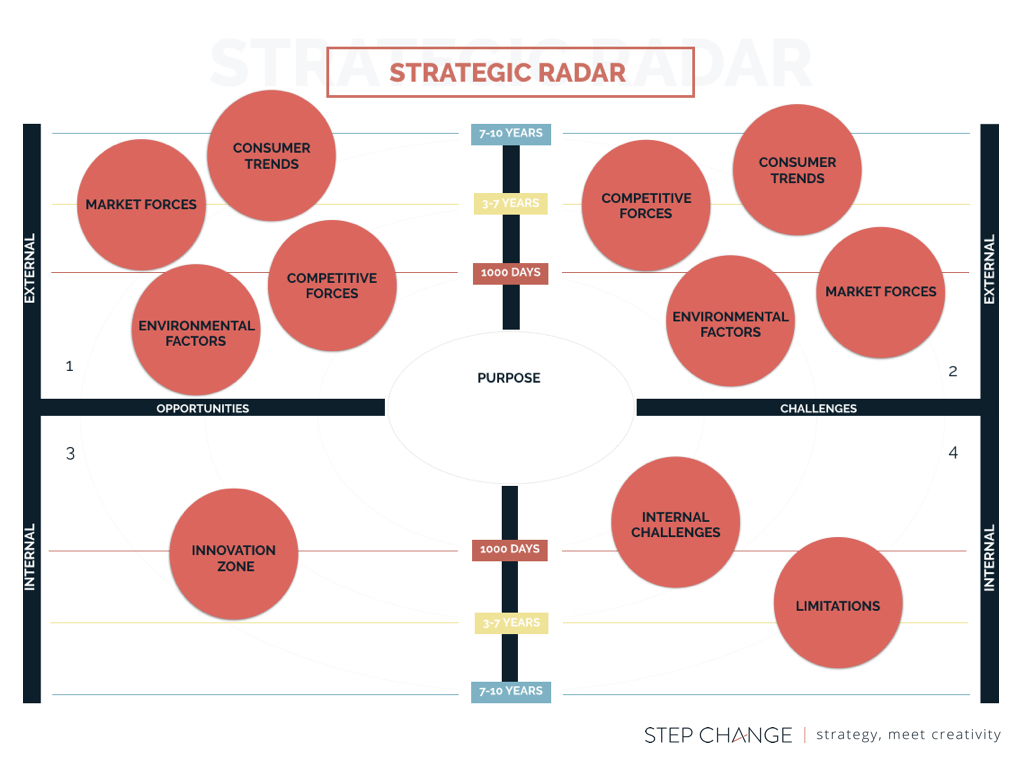 By Ashton Bishop, CEO at Step Change
By Ashton Bishop, CEO at Step Change
Recall the last time you conducted strategic planning with your team. Did your plans turn out to be successful? Or were you frustrated that last year’s SWOT analysis proved to be lacking?
In this blog post, I’d like to reveal the four reasons why you need to rethink using the SWOT tool—the strengths, weaknesses, opportunities and threats analysis—for your next strategic planning, and I’d like to share with you the tool I’ve been using.
1. It’s become a cliché. The real problem with the SWOT is not the tool itself—it’s that people do it to complete it rather than to seek to understand their context.
2. Information doesn’t get prioritized. People complete a SWOT by pulling out last year’s SWOT and just adding extra stuff. So they only get pages of information that’s not prioritized.
3. It’s too generic. The information that’s in the SWOT is too generic.
4. It’s not time-critical. SWOTs lull us into a false sense of security—it lets us think that we can somehow stop time. Now opportunities and challenges are time-critical. This means if we’re too early, we’re not effective. If we’re too late, we’re sometimes out of business. So it’s very important to have a tool that discusses the time-critical nature of the context, because if the context changes, then strategy has to change.
People want context to conform to their planning cycle. But that’s not the way the world works. So we’re better to work with a tool that indicates how the world works rather than fight against it.
So What Tool Works?
At Step Change, we’ve completely ditched the SWOT tool. We came up with a more effective tool to see the opportunities and challenges in our context. We call it the strategic radar, and we’ve also been helping our clients with their business strategies through it.
Here’s why this is effective for strategic planning:
1. The strategic radar asks eight essence questions to get specific. When you build a strategic radar, you are guided by 29 disruption factors and eight essence questions. The essence questions look at the relationship between your business and the context. The disruption factors are what they state (i.e. a disruption to the context, a dent in the universe or reality).

2. It’s all on one page. You get a single-page view of your external and internal opportunities and challenges, which effectively gives you the context you seek to understand.

3. It takes time into account. You actually get a sense of time by using the strategic radar. On a single page, you get the sense of what’s coming—in 1,000 days, in three to seven years, in seven to 10 years—and you start to be responsive and adaptive to it.
4. It forces prioritization. The circa 1956 George Miller research that says humans can hold seven plus or minus two bits of information was basically debunked by Norman Cowan, who said people can hold about four pieces of information.
So, if we stretch it and we say, “Maybe people can handle around six pieces of information,” then, at the most, we need the top three opportunities and the top three challenges in order.
Quadrants one and two are where you write down the market forces, competitive forces, consumer trends, and environmental factors.
Quadrant three is your internal opportunities. This is your innovation zone; this is where you look to leverage your strengths and advantages.
Quadrant four contains the internal challenges and limitations. These are the factors that get us stuck or stopped, limiting us on our ability to deliver the bottom-line strategy.
It was Bill Gates who famously said, “We always overestimate the change that will occur in the next two years and underestimate the change that will occur in the next ten.” This is exactly the purpose of the radar. Though we don’t control the way and the rate at which things are moving and changing, we can respond to it. So go ahead, give the strategic radar a try on your next planning.
This article first appeared on The Step Change Blog.
Ashton Bishop is Australia’s Predatory Thinker—an expert in pinpointing how businesses can grow by outsmarting their competitors. His niche is in strategy, where he has spent the last 14 years working internationally on some of the world’s biggest brands. He’s a business owner and serial entrepreneur; challenging, sometimes even controversial; but always focused on what gets results.
Since 1987, EO has been transforming the lives of the entrepreneurs who transform the world. Learn what it’s like to join the only global network exclusively for entrepreneurs.
Categories: Coaching FINANCES LEADERSHIP Productivity
